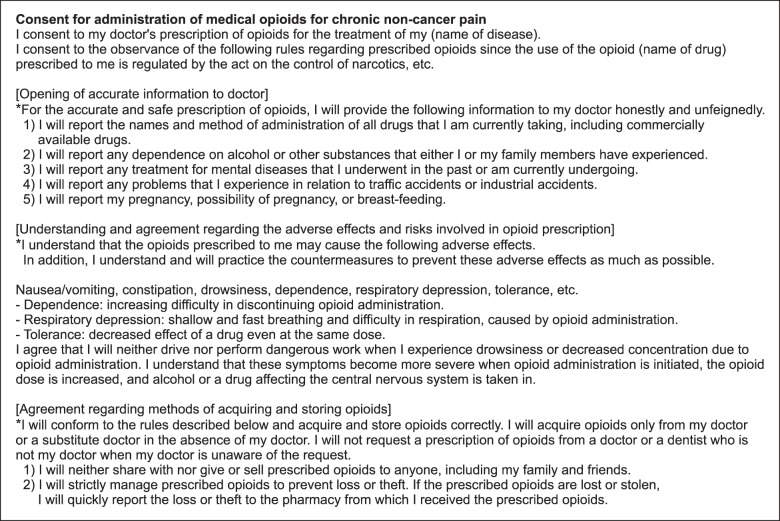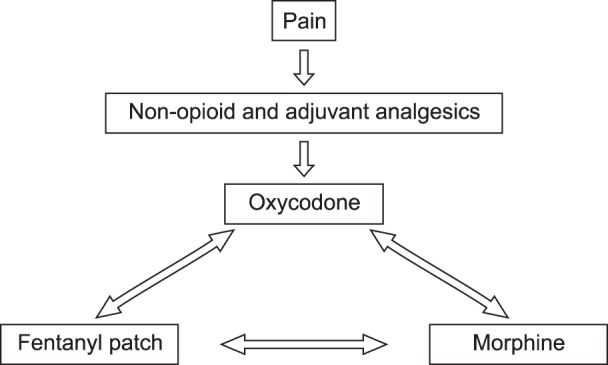Guidelines for prescribing opioids for chronic non-cancer pain in Korea
- Affiliations
-
- 1Department of Anesthesiology and Pain Medicine, Daejeon St. Mary's Hospital, College of Medicine, The Catholic University of Korea, Seoul, Korea.
- 2Department of Anesthesiology and Pain Medicine, Samsung Medical Center, School of Medicine, Sungkyunkwan University, Seoul, Korea.
- 3Department of Anesthesiology and Pain Medicine, Chonbuk National University Hospital, School of Medicine, Chonbuk National University, Jeonju, Korea.
- 4Department of Anesthesiology and Pain Medicine, Pusan National University Yangsan Hospital, School of Medicine, Pusan National University, Yangsan, Korea.
- 5Department of Anesthesiology and Pain Medicine, Kyungpook National University Medical Center, School of Medicine, Kyungpook National University, Daegu, Korea.
- 6Department of Anesthesiology and Pain Medicine, Kimchan Hospital, Suwon, Korea.
- 7Department of Anesthesiology and Pain Medicine, Soonchunhyang University Cheonan Hospital, College of Medicine, Soonchunhyang Univertisy, Cheonan, Korea.
- 8Department of Anesthesiology and Pain Medicine, Keimyung University Dongsan Medical Center, School of Medicine, Keimyung University, Daegu, Korea.
- 9Department of Anesthesiology and Pain Medicine, Seoul St. Mary's Hospital, College of Medicine, The Catholic University of Korea, Seoul, Korea. huejung@catholic.ac.kr
- KMID: 2365338
- DOI: http://doi.org/10.3344/kjp.2017.30.1.18
Abstract
- As the treatment of chronic non-cancer pain gradually increases, clinicians have more opportunities to encounter opioid prescription. However, guidelines for prescribing opioids for chronic non-cancer pain have never been published in Korea. The present guidelines were prepared by reviewing various research data. In cases in which the data were insufficient, recommendations were presented following discussion among experts affiliated with the Opioids Research Group in the Korean Pain Society. The present guidelines may need to be continuously revised and amended as more clinical evidence is acquired.
Keyword
Figure
Cited by 5 articles
-
Patients’ perception about opioids and addiction in South Korea
Cho Long Kim, Sung Jun Hong, Yun Hee Lim, Jae Hun Jeong, Ho Sik Moon, Hey Ran Choi, Sun Kyung Park, Jung Eun Kim, Hakjong You, Jae Hun Kim
Korean J Pain. 2020;33(3):234-244. doi: 10.3344/kjp.2020.33.3.234.Opioid: toward an effective strategy for better use
Yeon-Dong Kim
Korean J Pain. 2019;32(2):67-68. doi: 10.3344/kjp.2019.32.2.67.Actual situation and prescribing patterns of opioids by pain physicians in South Korea
Min Jung Kim, Ji Yeon Kim, Yun Hee Lim, Sung Jun Hong, Jae Hun Jeong, Hey Ran Choi, Sun Kyung Park, Jung Eun Kim, Min Ki Lee, Jae Hun Kim
Korean J Pain. 2022;35(4):475-487. doi: 10.3344/kjp.2022.35.4.475.Updated guidelines for prescribing opioids to treat patients with chronic non-cancer pain in Korea: developed by committee on hospice and palliative care of the Korean Pain Society
Minsoo Kim, Sun Kyung Park, Woong Mo Kim, Eunsoo Kim, Hyuckgoo Kim, Jun-Mo Park, Seong-Soo Choi, Eun Joo Choi
Korean J Pain. 2024;37(2):119-131. doi: 10.3344/kjp.24022.Perceptions of treatment, accompanying symptoms, and other problems in patients with chronic pain: a multicenter cross-sectional study in Korea
Jieun Bae, Yun Hee Lim, Sung Jun Hong, Jae Hun Jeong, Hey Ran Choi, Sun Kyung Park, Jung Eun Kim, Jae Hun Kim
Korean J Pain. 2025;38(1):69-78. doi: 10.3344/kjp.24314.
Reference
-
1. Paone D, Dowell D, Heller D. Preventing misuse of prescription opioid drugs. City Health Inf. 2011; 30:23–30.2. Webster LR, Webster RM. Predicting aberrant behaviors in opioid-treated patients: preliminary validation of the opioid risk tool. Pain Med. 2005; 6:432–442. PMID: 16336480.
Article3. Manchikanti L, Abdi S, Atluri S, Balog CC, Benyamin RM, Boswell MV, et al. American Society of Interventional Pain Physicians (ASIPP) guidelines for responsible opioid prescribing in chronic non-cancer pain: part 2--guidance. Pain Physician. 2012; 15:S67–S116. PMID: 22786449.4. The Committee for the Guidelines for Prescribing Opioid Analgesics for Chronic Non-cancer Pain of JSPC. Guidelines for prescribing opioid analgesics for chronic non-cancer pain. Tokyo: Shinko Trading Press;2012. p. 68–131.5. Webster LR, Dove B. Avoiding opioid abuse while managing pain: a guide for practitioners. North Branch (MIN): Sunrise River Press;2007.6. Yamaguchi T, Shima Y, Morita T, Hosoya M, Matoba M. Japanese Society of Palliative Medicine. Clinical guideline for pharmacological management of cancer pain: the Japanese Society of Palliative Medicine recommendations. Jpn J Clin Oncol. 2013; 43:896–909. PMID: 23885114.
Article7. Hwang IC, Shim JY. Opioids use for chronic noncancer pain. J Korean Med Assoc. 2013; 56:711–717.
Article8. Lee SY, Sohn KM, Ryu JY, Yoon YR, Shin JG, Kim JW. Sequence-based CYP2D6 genotyping in the Korean population. Ther Drug Monit. 2006; 28:382–387. PMID: 16778723.
Article9. Ko Y, Kim YH. The pharmacological management of neuropathic pain. J Korean Med Assoc. 2012; 55:582–592.
Article10. National Opioid Use Guideline Group (CA). Canadian guideline for safe and effective use of opioids for chronic non-cancer pain [Internet]. Ontario: Michael G. DeGroote National Pain Centre;2010. cited 2016 Oct 5. Available at http://nationalpaincentre.mcmaster.ca/opioid/.11. Sansone RA, Sansone LA. Tramadol: seizures, serotonin syndrome, and coadministered antidepressants. Psychiatry (Edgmont). 2009; 6:17–21.12. Park HJ, Moon DE. Pharmacologic management of chronic pain. Korean J Pain. 2010; 23:99–108. PMID: 20556211.
Article13. Chou R, Fanciullo GJ, Fine PG, Adler JA, Ballantyne JC, Davies P, et al. Clinical guidelines for the use of chronic opioid therapy in chronic noncancer pain. J Pain. 2009; 10:113–130. PMID: 19187889.
Article14. Dowell D, Haegerich TM, Chou R. CDC guideline for prescribing opioids for chronic pain--United States, 2016. JAMA. 2016; 315:1624–1645. PMID: 26977696.
Article15. Eisenberg E, McNicol ED, Carr DB. Efficacy and safety of opioid agonists in the treatment of neuropathic pain of nonmalignant origin: systematic review and meta-analysis of randomized controlled trials. JAMA. 2005; 293:3043–3052. PMID: 15972567.
Article16. Noble M, Treadwell JR, Tregear SJ, Coates VH, Wiffen PJ, Akafomo C, et al. Long-term opioid management for chronic noncancer pain. Cochrane Database Syst Rev. 2010; CD006605. PMID: 20091598.
Article17. Ma K, Jiang W, Zhou Q, Du DP. The efficacy of oxycodone for management of acute pain episodes in chronic neck pain patients. Int J Clin Pract. 2008; 62:241–247. PMID: 18070045.
Article18. Lemming D, Sörensen J, Graven-Nielsen T, Arendt-Nielsen L, Gerdle B. The responses to pharmacological challenges and experimental pain in patients with chronic whiplash-associated pain. Clin J Pain. 2005; 21:412–421. PMID: 16093747.
Article19. Lee WH. Use of opioid analgesics for the management of chronic noncancer pain. J Korean Pain Soc. 2004; 17(Suppl):S88–S93.
Article20. Geppetti P, Benemei S. Pain treatment with opioids: achieving the minimal effective and the minimal interacting dose. Clin Drug Investig. 2009; 29(Suppl 1):3–16.21. Kahan M, Wilson L, Mailis-Gagnon A, Srivastava A. National Opioid Use Guideline Group. Canadian guideline for safe and effective use of opioids for chronic noncancer pain: clinical summary for family physicians. Part 2: special populations. Can Fam Physician. 2011; 57:1269–1276. e419–e428. PMID: 22084456.22. Moulin DE, Iezzi A, Amireh R, Sharpe WK, Boyd D, Merskey H. Randomised trial of oral morphine for chronic non-cancer pain. Lancet. 1996; 347:143–147. PMID: 8544547.
Article23. Maxwell JC. The prescription drug epidemic in the United States: a perfect storm. Drug Alcohol Rev. 2011; 30:264–270. PMID: 21545556.
Article24. Cho YS, Lee JY, Kim HS, Kwon JH. Trends in the consumption of opioid analgesics in a tertiary care hospital from 2000 to 2012. Yakhak Hoeji. 2014; 58:268–276.25. Centers for Disease Control and Prevention (CDC). Vital signs: overdoses of prescription opioid pain relievers and other drugs among women--United States, 1999-2010. MMWR Morb Mortal Wkly Rep. 2013; 62:537–542. PMID: 23820967.26. Bohnert AS, Valenstein M, Bair MJ, Ganoczy D, McCarthy JF, Ilgen MA, et al. Association between opioid prescribing patterns and opioid overdose-related deaths. JAMA. 2011; 305:1315–1321. PMID: 21467284.
Article27. Gomes T, Mamdani MM, Dhalla IA, Paterson JM, Juurlink DN. Opioid dose and drug-related mortality in patients with nonmalignant pain. Arch Intern Med. 2011; 171:686–691. PMID: 21482846.
Article28. Ballantyne JC, Mao J. Opioid therapy for chronic pain. N Engl J Med. 2003; 349:1943–1953. PMID: 14614170.
Article29. Brennan MJ. The clinical implications of cytochrome p450 interactions with opioids and strategies for pain management. J Pain Symptom Manage. 2012; 44:S15–S22. PMID: 23218232.
Article30. Vissers KC, Besse K, Hans G, Devulder J, Morlion B. Opioid rotation in the management of chronic pain: where is the evidence? Pain Pract. 2010; 10:85–93. PMID: 20070552.
Article31. Hasin DS, O'Brien CP, Auriacombe M, Borges G, Bucholz K, Budney A, et al. DSM-5 criteria for substance use disorders: recommendations and rationale. Am J Psychiatry. 2013; 170:834–851. PMID: 23903334.
Article32. Degenhardt L, Bruno R, Lintzeris N, Hall W, Nielsen S, Larance B, et al. Agreement between definitions of pharmaceutical opioid use disorders and dependence in people taking opioids for chronic non-cancer pain (POINT): a cohort study. Lancet Psychiatry. 2015; 2:314–322. PMID: 26360084.
Article33. Starrels JL, Becker WC, Weiner MG, Li X, Heo M, Turner BJ. Low use of opioid risk reduction strategies in primary care even for high risk patients with chronic pain. J Gen Intern Med. 2011; 26:958–964. PMID: 21347877.
Article34. Manchikanti L, Manchukonda R, Damron KS, Brandon D, McManus CD, Cash K. Does adherence monitoring reduce controlled substance abuse in chronic pain patients? Pain Physician. 2006; 9:57–60. PMID: 16700282.35. Turk DC, Swanson KS, Gatchel RJ. Predicting opioid misuse by chronic pain patients: a systematic review and literature synthesis. Clin J Pain. 2008; 24:497–508. PMID: 18574359.
- Full Text Links
- Actions
-
Cited
- CITED
-
- Close
- Share
- Similar articles
-
- Prescribing Opioids for Chronic Pain
- Guidelines for prescribing opioids for chronic non-cancer pain in Korea: can you overcome “opiophobia�
- Updated guidelines for prescribing opioids to treat patients with chronic non-cancer pain in Korea: developed by committee on hospice and palliative care of the Korean Pain Society
- Use of Opioid Analgesics for the Management of Chronic Noncancer Pain
- Opioid Therapy for Chronic Nonmaliganat Pain




